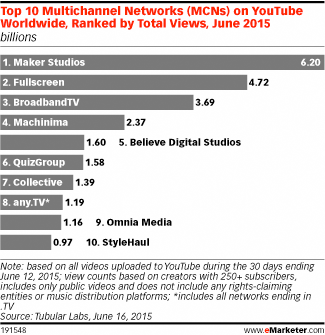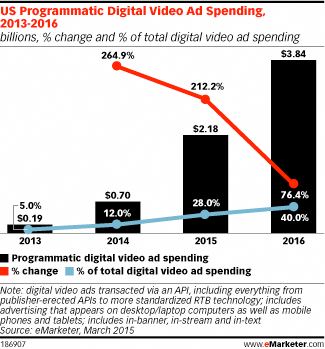Multichannel Networks and Branded Content: The Good, the Bad and the Future
July 14, 2015
![]() Multichannel networks (MCNs) have become a vital link between content creators and video platforms, in particular YouTube. These networks provide creators with production, promotion and marketing services in exchange for a (fairly large) percentage of ad revenues. At the same time, MCNs organize content in a way that video channels can monetize, according to a new eMarketer report, “Multichannel Networks and Digital-First Video Content: Growing Audiences Beyond the YouTube Core.”
Multichannel networks (MCNs) have become a vital link between content creators and video platforms, in particular YouTube. These networks provide creators with production, promotion and marketing services in exchange for a (fairly large) percentage of ad revenues. At the same time, MCNs organize content in a way that video channels can monetize, according to a new eMarketer report, “Multichannel Networks and Digital-First Video Content: Growing Audiences Beyond the YouTube Core.”
 Tubular Labs’ ranking of the top YouTube MCNs showed Maker Studios in the lead, with 6.20 billion YouTube views just in the month leading up to June 12, 2015. Other top MCNs such as Fullscreen, BroadbandTV and Machinima also amassed views in the multiple billions during that period.
Tubular Labs’ ranking of the top YouTube MCNs showed Maker Studios in the lead, with 6.20 billion YouTube views just in the month leading up to June 12, 2015. Other top MCNs such as Fullscreen, BroadbandTV and Machinima also amassed views in the multiple billions during that period.
An important aspect of the monetization of MCN content is that much of it comes not from pre-rolls or other standard media buys, but from branded entertainment, such as brand mentions, product placement or complete videos sponsored by brands. Branded entertainment should help MCNs monetize on platforms that currently do not accommodate standard pre-rolls, such as Facebook and Instagram.
 StyleHaul founder Stephanie Horbaczewski told The Wall Street Journal in November 2014 that half of her company’s YouTube revenues came from branded entertainment, while the other half came from standard Google ads.
StyleHaul founder Stephanie Horbaczewski told The Wall Street Journal in November 2014 that half of her company’s YouTube revenues came from branded entertainment, while the other half came from standard Google ads.
“When you look at the value of revenue, all parts are not created equal,” she said. “Yes, media revenue [i.e., money from pre-roll ads] is extremely important. But half our business is non-Google-dependent, and that’s a more valuable revenue source. It speaks to how incredible the branded content landscape is for us.”
Charlie Echeverry, chief revenue officer at MiTú Network, an MCN aimed at Hispanic consumers, said his company also generates revenues through a mix of models. “If you’re a brand that’s working with MiTú, you may have some percentage of your buy expressed in traditional pre-roll advertising, but you would also have some of your buy expressed in content marketing, or social amplification, outside of YouTube.”
Although branded content is a big revenue driver for many MCNs, it can be an inefficient way to monetize videos. Most branded content deals involve in-depth conversations, negotiations and collaborations between content creators and brands, with MCNs acting as intermediaries. This process can take weeks or months of back-and-forth approvals by various parties.
The sudden rise in programmatic video buying cuts against MCNs’ reliance on branded content. In 2015, US marketers will spend $2.18 billion on programmatic digital video advertising, a 212.2% increase over 2014, eMarketer estimates. And next year, the total will spike to $3.84 billion, a 76.4% increase. That means that by 2016, 40.0% of US video ad spending will occur programmatically.
Forward-looking executives at MCNs are taking note of this trend and making changes. Some, like StyleHaul, are implementing processes that can populate brand mentions across a wide pool of content from multiple creators.
“We are looking at this idea of an MCN that can produce content in real time,” said Alison Kennedy, chief revenue officer at StyleHaul, in the November 2014 article in The Wall Street Journal. “I think there is a way to automate that process. We have 5,000 creators. It shouldn’t be that hard to get 100 of them to talk about something they’d probably talk about anyway.”
Companies including Maker Studios, Fullscreen, Machinima and Collective Digital Studio are taking similar approaches, while also investing in data mining to better target their viewers.
Courtesy of eMarketer





























